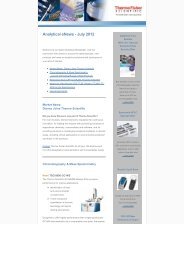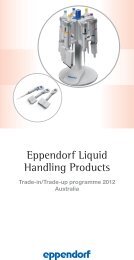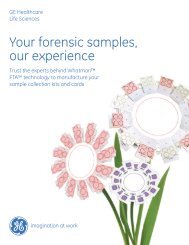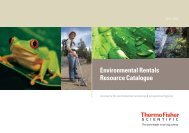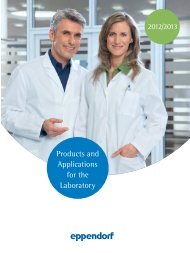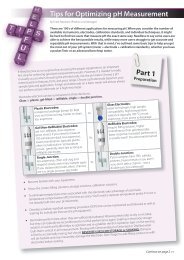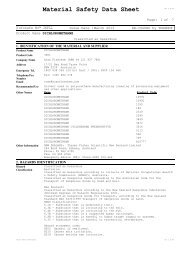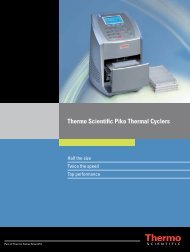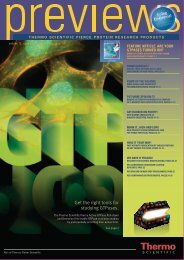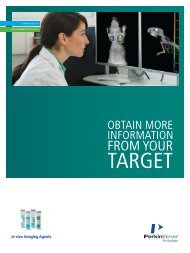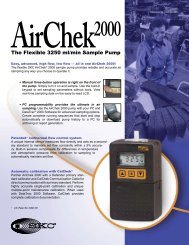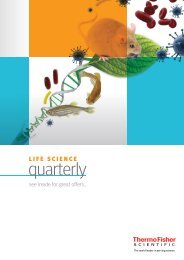Dairy Insider - Thermo Fisher
Dairy Insider - Thermo Fisher
Dairy Insider - Thermo Fisher
Create successful ePaper yourself
Turn your PDF publications into a flip-book with our unique Google optimized e-Paper software.
Volume 1 Jun/Aug 2013<br />
<strong>Insider</strong><br />
1300 735 292
welcome<br />
Welcome to the inaugural issue of<br />
the <strong>Dairy</strong> <strong>Insider</strong>. The team at <strong>Thermo</strong><br />
<strong>Fisher</strong> Scientific are thrilled to bring you<br />
a publication focussed on the unique<br />
needs of the dairy industry.<br />
In this issue, we bring to you information on some of our latest<br />
products including testing systems for ATP, pathogens, viscosity and<br />
waste monitoring<br />
Cassandra Anderson<br />
Category Manager<br />
Microbiology<br />
The team at <strong>Thermo</strong> <strong>Fisher</strong> Scientific values customer feedback and<br />
we’d love to hear your comments on the <strong>Dairy</strong> <strong>Insider</strong>. Please email us<br />
at<br />
with your comments.<br />
Thank you for taking time to read <strong>Dairy</strong> <strong>Insider</strong>. We look forward to<br />
hearing what you think. In the meantime, happy reading!<br />
contents<br />
The Science Behind Neogen’s<br />
AccuPoint ® ATP Sanitation Monitoring System<br />
Adenosine triphosphate (ATP) is found in every living cell. Since most of the food<br />
and drink we consume was at some point living, ATP is present in most residue that<br />
remains after a food contact surface is cleaned..........................................<br />
Zero in on Listeria<br />
with 3M Petrifilm <br />
In the past, testing alternatives were usually too expensive. Therefore, very few facilities<br />
were able to perform Listeria testing frequently and consistently enough to make<br />
actionable decisions based on results.........................................................<br />
Introducing you to the Microbiology team<br />
- combining unique strengths to bring you<br />
expertise, experience & innovation.<br />
<strong>Thermo</strong> <strong>Fisher</strong> Scientific offers microbiologists a broad portfolio of industry-leading<br />
brands, enabling us to offer you innovative workflow solutions. Some of the<br />
brands included in our range include Oxoid TM , Remel TM , Trek Diagnostics TM , 3M TM ,<br />
Qualicon TM and Idexx TM .<br />
Supporting the comprehensive range of market-leading brands is the Microbiology<br />
team. All members of the team have Microbiology laboratory experience and<br />
product expertise, and can therefore assist and support you in your technical needs.<br />
Please free feel to call us on 1300 735 292 if we can be of assistance to you.<br />
Setting the Standards<br />
in Viscosity Testing<br />
The explosive growth in spreadable butters and low-fat substitutes over the last decade<br />
is testament to the fact that spreadability is a key determinant in consumer acceptance<br />
and convenience.......................................................................................<br />
Product & Profit<br />
Going Down the Drain...?<br />
Spills, product changes and production issues at dairies and milk and cheese<br />
processing plants can result in profits being literally washed down the drain. Add to that<br />
the cost of treating sudden high carbon-load waste and the potential ..........<br />
2<br />
www.thermofisher.com.au 1300 735 292<br />
3
At Every Link in the<br />
<strong>Dairy</strong> Food Chain<br />
<strong>Thermo</strong> <strong>Fisher</strong> Scientific is at the forefront of food safety and testing,<br />
combining technical expertise and support with innovative products that<br />
analyse, inspect and verifiy dairy ingredients and products, from point of<br />
origin to the point of consumption. Our solutions strengthen the entire food<br />
chain so you can deliver the uncompromised dairy products that consumers<br />
expect and deserve.<br />
• For more information visit www.thermofisher.com.au or call 1300-735-292<br />
Laboratory Consumables Microbiology<br />
Laboratory Equipment Life Science Chromatography Environmental & Industrial<br />
• Blender Bags<br />
• Chemicals<br />
• Filter Papers<br />
• Glassware<br />
• Loops and Spreaders<br />
• Petri dishes<br />
• Tubes and Bottles<br />
• Allergen kits<br />
• Antibiotic residue test kits<br />
• ATP – sanitation monitoring<br />
• Dehydrated culture media<br />
• Instrumentation<br />
• Food Borne Pathogen Detection<br />
(including molecular methods)<br />
• Petrifilm TM<br />
• Plates and Tubes<br />
• Pre poured media & diluents<br />
• Swabs<br />
• Autoclaves<br />
• Balances<br />
• Biosafety Cabinets<br />
• Centrifuges<br />
• Cold Storage<br />
• Incubators<br />
• Ovens<br />
• Stirrers<br />
• Waterbaths<br />
• Water Purification<br />
• Filtration<br />
• Immunoassays<br />
• Liquid Handling<br />
• Molecular Biology Reagents<br />
• PCR & QPCR Instruments,<br />
Reagents & Consumables<br />
• Titration<br />
• Accelerated solvent extraction (ASE)<br />
• Chromatography solvents<br />
• Gas chromatography – GC, GCMS<br />
• Ion chromatography<br />
• Liquid chromatography – HPLC, LCMS<br />
• Protein separation columns<br />
• Syringe filters<br />
• Solid phase extraction<br />
• Tubing & fittings<br />
• Vials & closures<br />
• Air quality monitoring<br />
• COD (Chemical Oxygen Demand)<br />
• Data logging<br />
• Dust monitoring<br />
• Heat stress monitoring<br />
• Methane gas monitoring<br />
• Noise monitoring<br />
• Odour monitoring<br />
• pH, conductivity, salinity, turbidity<br />
4<br />
www.thermofisher.com.au 1300 735 292<br />
5
The Science Behind Neogen’s<br />
AccuPoint ® ATP Sanitation Monitoring System<br />
Author:<br />
Robert Artuso<br />
International Sales<br />
Manager Neogen<br />
Corporation<br />
bartuso@neogen.<br />
com<br />
Adenosine triphosphate (ATP) is<br />
found in every living cell. Since<br />
most of the food and drink we<br />
consume was at some point living,<br />
ATP is present in most residue<br />
that remains after a food contact<br />
surface is cleaned.<br />
ATP is also present in bacteria as well<br />
as yeast and mold or other spoilage<br />
organisms.<br />
For this reason, the measurement of ATP<br />
levels on a food contact surface or within<br />
a water sample has become the de-facto<br />
standard food and beverage producers<br />
utilise to determine the cleanliness levels<br />
of their operations.<br />
Buffer<br />
The AccuPoint Sampler<br />
Luciferase and luciferin<br />
on reagent pad<br />
ATP is collected<br />
on the sample pad<br />
ATP from the sample pad<br />
combines with the reagents<br />
and a chemiluminescent<br />
reaction begins<br />
What ATP systems can’t do<br />
ATP systems are not designed for total plate counts, or<br />
detecting food allergens.<br />
ATP results do not correlate with<br />
microbial counts<br />
A common misconception is that the results received from<br />
ATP testing systems in relative light units (RLUs) for surface<br />
samples, for example, should in some way correlate with a<br />
microbial total plate count result for the same samples.<br />
The amount of ATP in microbial cells can vary dramatically<br />
and a single CFU can actually be comprised of one cell or<br />
many cells. Bacteria need food to grow, and therefore, there<br />
will never be an occasion where there is only microbial ATP<br />
on a surface.<br />
In theory there is a correlation between CFU levels and RLU<br />
units; however, it is impossible to determine whether the<br />
RLU results are due to the presence of bacteria, yeast, mold<br />
or food residue. Most probably, it is a combination of these<br />
things.<br />
ATP systems are not direct indicators of bacterial presence;<br />
however, they are the fastest and most convenient method<br />
for determining the potential for these organisms to exist<br />
on your food contact surface - therefore an indication of<br />
how clean your surfaces are. There is simply no faster or<br />
easier way to know that you could have a problem or that<br />
certain areas in your facility require more vigorous cleaning.<br />
Therefore, the issue can be corrected before it becomes a<br />
serious problem.<br />
ATP testing is a poor tool in an<br />
allergen control program<br />
Another misconception is the use of ATP sanitation<br />
monitoring systems in a food allergen control program. The<br />
theory here is that if all or most of the ATP on a surface or<br />
in a clean-in-place (CIP) system has been eliminated, all<br />
of the possible allergenic protein has also been eliminated.<br />
This is not the case as 1) An allergenic protein can exist on<br />
a surface at up to 100 times the level of concern and still be<br />
below the detection level of any ATP system; and 2) You can’t<br />
know how much of an ATP result is from an allergenic protein<br />
and how much is from something else.<br />
So why use an<br />
ATP monitoring system?<br />
»<br />
»<br />
The purpose of ATP testing is to achieve and defensively<br />
document effective cleaning by following the principle<br />
that if biomass is not present on surfaces after cleaning<br />
there is not enough medium for microbial growth.<br />
Properly utilised, sanitation monitoring systems allow for<br />
the almost instantaneous detection and measurement<br />
of ATP on food contact surfaces, which provides an<br />
objective, actionable tool for the monitoring of a facility’s<br />
sanitation efforts.<br />
Exclusive <strong>Dairy</strong> <strong>Insider</strong> Special<br />
For a limited time only the AccuPoint 2<br />
ATP Sanitation Monitoring system is $3600<br />
saving you $500 on upfront investment.<br />
This package includes software, USB data<br />
cable, battery charger, mobile carry case<br />
and training DVD.<br />
*Hurry this offer ends 31st August 2013.<br />
Quote promo code NEO9602<br />
Call 1300 735 292 to place your order or go to<br />
www.thermofisher.com.au/godirect to order online.<br />
$3600 *<br />
NEO9602<br />
6<br />
www.thermofisher.com.au<br />
1300 735 292<br />
7
Zero in on Listeria<br />
with 3M Petrifilm <br />
You can’t afford not to do it!<br />
3M Petrifilm Environmental<br />
Listeria Plates: the better way<br />
to manage Listeria<br />
In the past, testing alternatives were usually too expensive.<br />
Therefore, very few facilities were able to perform Listeria testing<br />
requently and consistently enough to make actionable decisions<br />
based on results. This resulted in thousands of dollars spent on<br />
environmental Listeria tests that were not actionable.<br />
By implementing control procedures and increased testing<br />
of environmental Listeria as an indicator, you can reduce<br />
Listeria monocytogenes contamination. The 3M Petrifilm<br />
Environmental Listeria plate is a powerful tool that will help you<br />
manage Listeria.<br />
Test more often.<br />
By testing more consistently you can monitor the levels<br />
of Listeria in different parts of your plant. The 3M<br />
PetrifilmEnvironmental Listeria Plates is cost effective,<br />
allowing you to test more often than ever before without<br />
increasing your budget.<br />
Monitor Listeria levels.<br />
With consistent, frequent testing, the 3M Petrifilm<br />
Environmental Listeria Plate’s quantitative results will allow you<br />
to monitor any significant changes in environmental Listeria<br />
levels and take informed and precise action.<br />
The right choice for your facility.<br />
The 3M Petrifilm Environmental Listeria Plate is a proven<br />
and cost-effective tool for the detection of environmental Listeria.<br />
• Quantitative results allow you to identify hot spots in the<br />
plant and track your progress against Listeria over time.<br />
• Rapid results in 27-31 hours from sample collection.<br />
• Safer method - no enrichment, no culture transfers.<br />
• Easy to use 3M Petrifilm Plate Technology.<br />
Now, with the availability and cost-effectiveness of the<br />
3M Petrifilm Environmental Listeria Plates, tracking and<br />
managing Listeria is easy.<br />
Zero in on the source of Listeria<br />
Because Listeria is an organism that occurs naturally in the<br />
environment, there are plenty of opportunities to continually<br />
reintroduce it into the processing plant. One effective way to<br />
control Listeria is by monitoring the levels of environmental<br />
contamination in different parts of the plant.<br />
By identifying and eliminating Listeria away from your<br />
production you can minimise your risks.<br />
ZONE 4<br />
ZONE 3<br />
Remote: eg. doorways, halls, drains<br />
Non-Food Contact: eg. table legs, floor<br />
Non-Food Contact: eg. equipment panels, aprons<br />
ZONE 2<br />
ZONE 1<br />
Perform more<br />
environmental tests here<br />
Food Contact: eg. utensils,<br />
conveyor, chutes, people<br />
To prevent food<br />
contamination here<br />
How does a qualitative result help?<br />
When Listeria is found within a processing environment<br />
the source can often be traced back to a single point or<br />
“hot spot” from which the contamination has spread. To<br />
effectively control the threat of Listeria these hot spots must<br />
be identified and to do this, information is vital.<br />
Consider the two examples showing the results of<br />
environmental sampling surrounding a food contact surface.<br />
The qualitative results are unable to provide the information<br />
needed to make an informed decision about the likely<br />
location of the hot spot.<br />
By using a quantitative method as shown, a more effective<br />
response may be undertaken by zeroing in on the hot spot<br />
faster and allowing for more thorough treatment or change to<br />
prevent repeat occurrences.<br />
Plating Technique Video<br />
Qualitative<br />
Quantitative<br />
Current<br />
Method<br />
3M Petrifilm<br />
Environmental<br />
Listeria (EL)<br />
Plates Method<br />
Contact surface<br />
sample point<br />
Sample Sample using a using swab a or swab sponge or sponge<br />
Inner near<br />
sample point<br />
Inner far<br />
sample point<br />
- + - + -<br />
- - - - +<br />
- - - + -<br />
- - - - +<br />
- - + + -<br />
0 5 0 3 0<br />
0 0 0 0 7<br />
0 0 0 2 0<br />
0 0 0 0 24<br />
0 0 85 TNTC 0<br />
Get results in 27-31 hrs from<br />
sample collection<br />
Traditional Listeria testing methods require two or more<br />
days before your test is complete, allowing Listeria to go<br />
unchecked while you wait for the result.<br />
Add buffered Add buffered peptone peptone water. water.<br />
Wait one Wait hour. one hour.<br />
The 3M Petrifilm Environmental Listeria Plate result<br />
is ready by the following day, giving you the power to make<br />
faster decisions and react to problem areas.<br />
Perform Listeria Tests with a safer method than enrichment.<br />
Unlike traditional methods, the 3M Petrifilm<br />
Environmental Listeria Plate requires no enrichment or<br />
culture transfers. This means less risk of cross-contamination<br />
in your facility.<br />
Detect multiple Listeria species.<br />
The 3M Petrifilm Environmental Listeria Plate allows<br />
you to detect the most prevalent environmental Listeria<br />
species, including Listeria monocytogenes.<br />
Current Method vs. 3M Petrifilm Environmental Listeria Plates<br />
Day 1 Day 2<br />
10 am<br />
Take sample<br />
and perform<br />
enrichment<br />
Enrichment<br />
time ranges<br />
from 24-72<br />
hrs<br />
10 am 4pm<br />
Sample<br />
and test<br />
with Petrifilm<br />
EL Plate<br />
Result<br />
Ready<br />
Day<br />
3<br />
Day<br />
4<br />
Testing time<br />
ranges from<br />
1-48 hrs<br />
Fast, Easy and more informative<br />
Sample Sample using a using swab a or swab sponge or sponge<br />
Inoculate Inoculate and incubate and incubate<br />
for 26-30 for hours 26-30 hours<br />
Add buffered Add buffered peptone peptone water. water.<br />
Wait one Wait hour. one hour.<br />
Read and Read interpret and interpret<br />
3M Petrifi lm Environmental<br />
Listeria Plates<br />
More informative results than presence/absence tests<br />
3M Petrifi lm Environmental Listeria Plate provides you<br />
with the information to take the appropriate action.<br />
By using the quantitative results from 3M Petrifi lm<br />
Environmental Listeria Plates as part of your overall control<br />
plan against Listeria, you can know exactly where to target<br />
your actions to best detect, manage and prevent Listeria in<br />
your environment.<br />
3M Petrifilm Environmental Listeria Plate<br />
Sample A Sample B Sample C<br />
Traditional Presence/Absence Test<br />
Sample A Sample B Sample C<br />
(-) (+) (+)<br />
Order Now!<br />
$580<br />
Item Code Description UOM<br />
3M6447-SU Environmental Listeria Start Up Kit:<br />
- 3M6447 Petrifilm Environmental Listeria plates 50pcs<br />
- 3M6432 Quick Swab 50pcs<br />
- 3M6481 Petrifilm count plate spreader<br />
- TM1453 Buffered Peptone Water 25mL pk/10<br />
EA<br />
Inoculate Inoculate and incubate and incub<br />
for 26-30 for hours 26-30 hours<br />
Authorised Distributor<br />
8<br />
www.thermofisher.com.au 1300 735 292<br />
9
Setting the Standards<br />
in Viscosity Testing<br />
R/S-SST Plus Rheometer<br />
Soft Solids Tester for pastes, slurries and materials with<br />
particulates<br />
Butter & Margarine<br />
Spreadability<br />
The explosive growth in spreadable<br />
butters and low-fat substitutes over<br />
the last decade is testament to the fact<br />
that spreadability is a key determinant<br />
in consumer acceptance and<br />
convenience.<br />
The spreadability of a product is a<br />
function of it’s yield stress, the stress<br />
that is required to overcome the<br />
elastic structure present in a product<br />
and cause it to flow. The SST Soft<br />
Solids Tester offers an excellent way<br />
of measuring such products quickly,<br />
simply and reliably.<br />
The Soft Solids Tester uses a vaned spindle that is lowered<br />
into the sample to a pre-set insertion point prior to taking a<br />
measurement. The vane has two big advantages for testing<br />
such products:<br />
1. There is very little damage to the sample’s structure during<br />
vane insertion so we measure the sample as it really is,<br />
2. Yellow fats products are notoriously prone to slippage<br />
when in contact with smooth and shiny surfaces such as the<br />
cones and plates of rheometers. When a vane the moving<br />
element is effectively made of the sample itself and so<br />
slippage is virtually eliminated.<br />
A typical test method for spreadability assessment is to<br />
insert a V20-10 vane (20mm high by 10mm across) into<br />
the sample, rotate it at a predetermined rate of 0.5 rpm<br />
and record the stress across the sample every second.<br />
The results of this test performed on two samples at 6´C,<br />
a traditional butter and it’s newer spreadable version are<br />
shown in Figure 1.<br />
The higher yield stress of traditional butter is immediately<br />
obvious. The Soft Solids Tester’s analysis software reveals<br />
these values to be 10287 Pa for the traditional and 3636<br />
Pa for the spreadable version. This information is of obvious<br />
value when we wish to set benchmarks for our desired<br />
product qualities.<br />
Figure 2 shows a comparison of two competing<br />
spreadable butters and a margarine. A rounder peak and<br />
less pronounced drop in stress after the yield point is<br />
characteristic of ‘butteryness’ in a product. The sharp peak of<br />
margarine indicates a certain ‘brittleness’ in the structure.<br />
The Soft Solids Analysis software for the SST gives us yield<br />
values of:<br />
• Butter 1 3636 Pa<br />
• Butter 2 1861 Pa<br />
• Margarine 2937 Pa<br />
The Soft Solids Tester can output these results numerically,<br />
via the onboard lcd display; or graphically via the RS-SST’s<br />
control and analysis software. For quality control usage Pass/<br />
Fail tolerance bands can be set up for each product giving an<br />
immediate visual screening of tested batches.<br />
Stress [Pa]<br />
Stress [Pa]<br />
12000<br />
10000<br />
8000<br />
6000<br />
4000<br />
2000<br />
Traditional butter<br />
Spreadable butter<br />
0<br />
0 10 20 30 40 50 60 70<br />
Time [s]<br />
Figure 1<br />
4000<br />
Spreadable butter 1<br />
3500<br />
3000<br />
2500<br />
2000<br />
Margarine<br />
1500<br />
1000 Spreadable butter 2<br />
500<br />
0<br />
0 10 20 30 40 50 60 70<br />
Time [s]<br />
Figure 2<br />
Figure 1<br />
The results of this<br />
test performed on<br />
two samples at<br />
6´C, a traditional<br />
butter and it’s<br />
newer spreadable<br />
version<br />
Figure 1<br />
A comparison of<br />
two competing<br />
spreadable butters<br />
and a margarine.<br />
Measured Values<br />
- Yield Stress<br />
- Shear Modulus<br />
- Recovery<br />
- Creep<br />
Quantifies meaningful properties like stiffness,<br />
wobbliness, sloppiness, consistency and texture<br />
Capable of measurements in BU units for highly<br />
viscous materials such as joint compound for gypsum<br />
Vane Spindle Geometry<br />
• Quick-Connect coupling<br />
• Easy-to-test method<br />
• Allows spindle insertion without compromising<br />
sample structure<br />
Coaxial Cylinders can also be used for complete flow<br />
curve analysis<br />
Smooth Height Adjustment for easy insertion of<br />
spindle into sample without disrupting structure of sample<br />
Need more information?<br />
Call our Industrial Process team on 1300 735 295 or email<br />
10<br />
www.thermofisher.com.au 1300 735 292<br />
11
With the<br />
QuickCODultra<br />
the analytical area<br />
is isolated from<br />
the electronics<br />
so that not even<br />
a leakage can<br />
cause a damage.<br />
All areas are easily<br />
accessible.<br />
Product &<br />
Profit<br />
Spills, product changes and<br />
production issues at dairies and<br />
milk and cheese processing<br />
plants can result in profits being<br />
literally washed down the drain.<br />
Add to that the cost of treating<br />
sudden high carbon-load waste<br />
and the potential resultant high<br />
discharge-to-sewer costs and<br />
it makes sense to use reliable<br />
online analysers to monitor the<br />
process.<br />
Waste Monitoring<br />
Waste discharge from production, whether due to a spill<br />
or due to the changing of products, results in a high COD<br />
load for waste treatment. If the COD peak can be detected,<br />
decisions can be made regarding its processing:<br />
• A high COD load treated by an on-site DAF unit, for<br />
example, may overload the treatment process. Switching<br />
the waste flow to an offline buffer tank, to then feed<br />
back to waste once the peak has passed, provides a<br />
balanced flow to the DAF.<br />
• Monitoring at the point of discharge-to-sewer can<br />
provide details of COD loads for discharge cost<br />
purposes.<br />
• And if a high COD load is detected at discharge, the<br />
waste can be diverted for re-treatment rather than<br />
discharged, so saving on discharge costs.<br />
• In addition, detecting the COD peak at various points<br />
in the process can pin point where/why the peak is<br />
occurring and reduce loss of product and the associated<br />
costs<br />
Detect with QuickCODultra<br />
QuickCODultra, from LAR Process Analysers, is a rugged,<br />
reliable online COD analyser, designed for these challenging<br />
dairy applications. With a measuring range of 0.1mg/l<br />
Going<br />
Down<br />
the Drain...?<br />
to 200,000mg/l, the analyser is suitable for monitoring<br />
raw waste from production, even with fats and grease, or<br />
measuring the clean treated effluent.<br />
In contrast to the common standard measuring methods,<br />
which are time consuming and require hazardous reagents,<br />
QuickCODultra uses the thermal combustion method. A<br />
temperature of 1200°C ensures complete chemical digestion<br />
of all compounds in the sample, including any particles and<br />
without the need for the expensive catalysts used by lower<br />
temperature analysers. Oxygen consumption is measured<br />
using a zirconium oxygen sensor in order to provide a true<br />
online COD measurement. Even with changing sample<br />
matrices, the analyser delivers reliable and accurate results.<br />
Ultra quick measurement and<br />
maintenance<br />
The COD measurement takes place in less than two minutes.<br />
Thereby, rapidly changing peaks can be shown reliably. The<br />
maintenance required is also quick: less than 30 minutes per<br />
week. Moreover, all areas of the analyser have been designed<br />
for easy maintenance: from filter-less sample extraction<br />
with the patented FlowSampler ® , through the large and<br />
blockage-free tubes, to the catalyst-free high temperature<br />
oven with the removable oven foot for the quick removal of<br />
salt residues.<br />
Measurement Principle<br />
The analysis cycle has three steps, per the schematic below:<br />
1. Sample Transport, via robot X-Y movement<br />
a. Extraction of the sample from the sample overflowcollecting<br />
vessel<br />
b. Injection of the sample into the furnace oven<br />
c. Rinsing of the injection needle<br />
2. Sample Combustion in the oven<br />
3. Oxygen measurement by Zirconium Oxygen Sensor<br />
MEASUREMENT PRINCIPLE<br />
of the QuickCODultra<br />
Carrier Gas<br />
2<br />
Combustion<br />
Two Zone Oven<br />
b<br />
1.200°C<br />
Cooler<br />
Options<br />
The following options are available:<br />
• Up to six sample streams<br />
• Additional sensors for TOC measurement and TN<br />
(total nitrogen) measurement<br />
• High salt option up to 300g/l<br />
• Stainless steel cabinet, ATEX Zone1, Zone2<br />
ADVANTAGES & FEATURES<br />
Exact determination of the real COD<br />
Proven thermal oxidation principle<br />
Highest combustion temperature available (1,200°C)<br />
Catalyst-free<br />
Clean measurements without reagents<br />
Multi-stream measurements (optional)<br />
High salt concentrations of up to 100 g/l<br />
Individually programmable user levels<br />
Analyser availability minimum 98%<br />
Maintenance and service maximum 30 minutes per week<br />
Exceptionally low maintenance and operational costs<br />
Injection Module<br />
c<br />
Rinsing<br />
Vessel<br />
Standard<br />
Samples<br />
1–6 Sample Collecting Vessels<br />
(according to sample streams)<br />
Acid Trap Air Filter O 2 -Detector Detectors<br />
3<br />
a<br />
Measurement<br />
Need more information?<br />
Call our Environmental and Industrial Process team on 1300 735 295 or email<br />
1<br />
12<br />
www.thermofisher.com.au 1300 735 292<br />
13
July-September 2013<br />
OUT NOW!<br />
Lab Essentials<br />
For every step of the way.<br />
Microbiology Edition.<br />
bringing more<br />
to microbiology<br />
Microbiological media are vital to the recovery and health of<br />
patients and consumers. <strong>Thermo</strong> <strong>Fisher</strong> Scientific manufacture<br />
routine and specialty media which are available every day for<br />
every need.<br />
Browse our July-September 2013<br />
edition of Lab Essentials, focusing on<br />
essential microbiology consumables for<br />
your laboratory.<br />
to view the<br />
brochure or call 1300 735 292 to request<br />
a copy.<br />
Australia: For customer service, call 1300-735-292<br />
Visit us online at: www.thermofisher.com.au<br />
New Zealand: For customer service, call 0800-933-966<br />
Visit us online at: www.thermofisher.co.nz<br />
©2013 <strong>Thermo</strong> <strong>Fisher</strong> Scientific Inc. All rights reserved.<br />
1369274835-01-RM



